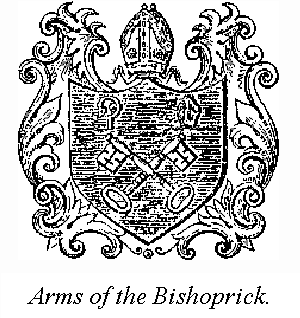EPISCOPAL SEE OF LIMERICK
The EPISCOPAL SEE of LIMERICK, one of the eleven which constitute the ecclesiastical province of Cashel, is 27 miles in length and 17 in breadth, extending over an estimated surface of 306,950 acres, of which 12,500 are in Clare and the remainder in Limerick. It is said to have been founded in the 6th or 7th century by St. Munchin, who was consecrated bishop of it by St. Patrick. No further mention is made of the bishoprick until after the settlement of the Ostmen or Danes in Limerick, and their subsequent conversion to Christianity, when, about the year 1110, Gille, or Gilbert, a Dane, who disclaimed the authority of the Irish prelates, was consecrated by the Archbishop of Canterbury and governed the see till 1140. In the charter of Donald O'Brien, King of Limerick, in 1194, the bishops are called Lumnicenses and Lumnicani, from Lumniach, the Irish name of the city. In 1195, the ancient see of Inniscathay or Inniscattery was united with this bishoprick.
It is said to have been founded in the 6th or 7th century by St. Munchin, who was consecrated bishop of it by St. Patrick. No further mention is made of the bishoprick until after the settlement of the Ostmen or Danes in Limerick, and their subsequent conversion to Christianity, when, about the year 1110, Gille, or Gilbert, a Dane, who disclaimed the authority of the Irish prelates, was consecrated by the Archbishop of Canterbury and governed the see till 1140. In the charter of Donald O'Brien, King of Limerick, in 1194, the bishops are called Lumnicenses and Lumnicani, from Lumniach, the Irish name of the city. In 1195, the ancient see of Inniscathay or Inniscattery was united with this bishoprick.
In 1284, Gerald le Mareschal succeeded in recovering the episcopal property which had been usurped by the bishops of Emly and Killaloe during the period the Danish bishops held it under the archbishop of Canterbury. This property was extensive and valuable at the Reformation; but. was afterwards so much diminished by grants to the Fitzgerald family that the see of Ardfert and Aghadoe was added to it in 1660, and has ever since been annexed to it. The see of Limerick is valued in the king's books at £40 sterling, according to an extent returned in the 5th of Charles I.
The see lands comprise 6720 acres; the gross yearly revenue of the bishoprick, including Ardfert and Aghadoe, amounted to £5368. 13. 5., on an average of three years ending Jan. 1, 1832. The palace is a modern brick edifice in the New town, with a front to the Shannon, commanding an extensive view of the opposite shores of the county of Clare. The consistorial court is held in the city by the vicar-general, with a surrogate and registrar, who is keeper of the Diocesan records, the oldest of which is intituled the "Liber Niger," copied by Bishop Adams in 1616, from a book which he states to have been then much defaced by age, and to contain an account of all the parishes, their procurations, taxation, subsidies, &c.
County Limerick | Limerick City | Topography | Barracks | Manufacturing | Port | Port Improvements | Markets | Corporation | Government | Courthouse | Episcopal See | Cathedral | Parishes | Hospitals | Almshouses | Antiquities | Notable Limerick Men
